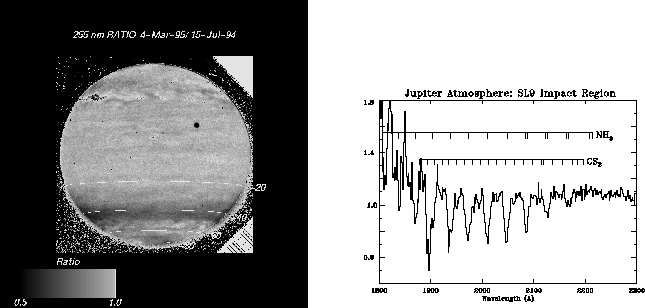|
The FOS GTO data analysis projectThe FOS GTO data analysis project had its headquarters
at UCSD and UCSD investigators continue to be active in HST research
programs. Among the important results from the FOS team was conclusive
evidence for the presence of a massive black hole in the nucleus of
the nearby elliptical galaxy, M87.
FOS PROVES THE EXISTENCE OF MASSIVE BLACK HOLE
Shown above is a sample of the spectrum obtained by the UCSD Faint Object Spectrograph onboard the Hubble Space Telescope that provided proof of the existence of black holes. Also available is the full press release photo (180k GIF or 80k JPEG). Hubble finds new black hole and unexpected mysteriesConfirming the presence of yet another super-massive
black hole in the universe, astronomers using NASA's Hubble Space Telescope
have also found unexpected new mysteries. The black hole and an 800
light-year-wide spiral-shaped disk of dust fueling it, are slightly
offset from the center of their host galaxy, NGC 4261, located 100 million
light-years away in the direction of the constellation Virgo.
Comet Discoveries with HST(This section from Science
with HST II contains many results obtained with the FOS)
Planetary Science with HST
Hot Luminuos Stars in Nearby Galaxies(This section from Science
with HST II contains many results obtained with the FOS)
Improved evidence for a black hole in M32 from HST/FOS spectra - I. ObservationsFOS Composite Quasar Spectrum(Originally from this
STScI page)
This is a quasar spectrum, between 350 and 3000 Å, constructed from 284 FOS observations of 101 quasars with redshifts z > 0.33, as described in Zheng, W., et al. 1997 ApJ,475,469, from the 1 Feb issue of The Astrophysical Journal. This reduced archival data is made available courtesy of Wei Zheng. The spectrum is available as a flat ASCII file:
The table columns are:
|



 M87 Core & Accretion Disk
M87 Core & Accretion Disk  Blue- and Red- shifted spectra
Blue- and Red- shifted spectra

